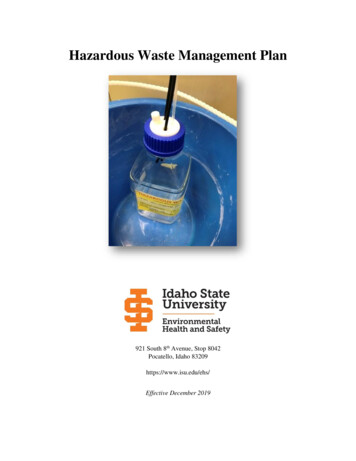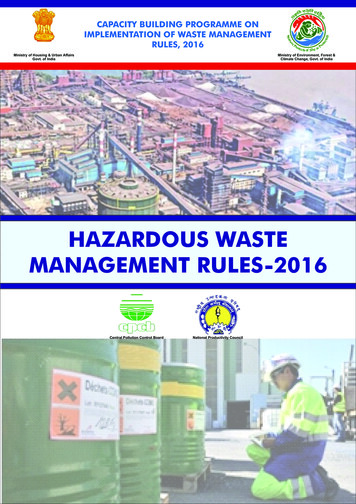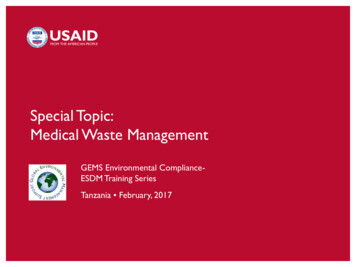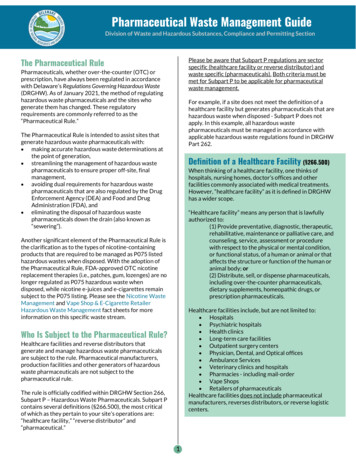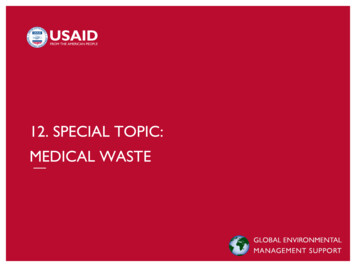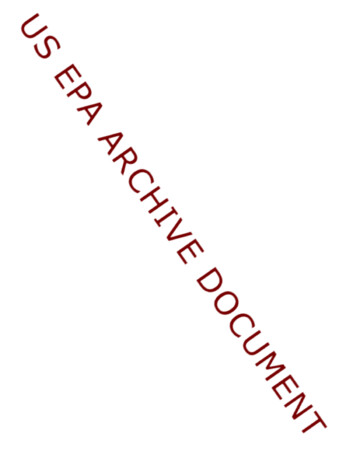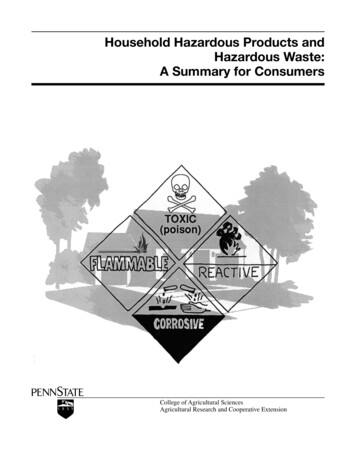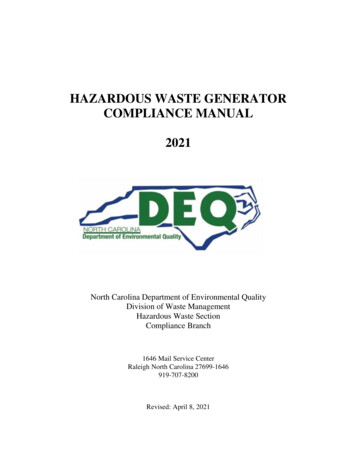
Transcription
HAZARDOUS WASTE GENERATORCOMPLIANCE MANUAL2021North Carolina Department of Environmental QualityDivision of Waste ManagementHazardous Waste SectionCompliance Branch1646 Mail Service CenterRaleigh North Carolina 27699-1646919-707-8200Revised: April 8, 2021
TABLE OF CONTENTSINTRODUCTION. 7Organizational Charts . 8Division of Waste Management . 8Hazardous Waste Section. 8Compliance Branch and Environmental Specialist Contacts . 9North Carolina Hazardous Waste Management Rules Overview . 10REGULATION SUMMARY . 11Identification of Hazardous Wastes . 11Characteristics of Hazardous Wastes . 13Listing of Hazardous Wastes . 15Hazardous Waste Mixtures . 19Wastes Derived from Hazardous Wastes . 20Listed Hazardous Waste in Soil . 21Exclusions . 21Residues of Hazardous Waste in Empty Containers . 28Categories of Hazardous Waste Generators. 30Generator Category Determination . 32Determining Your Generator Category . 32Notification of Hazardous Waste Activity . 36Re-notification. 36Hazardous Waste Determination . 37Regulations Applicable to Very Small Quantity Generators . 42Regulations Applicable to Satellite Accumulation Areas . 45Regulations Applicable to Small Quantity Generators . 47Regulations Applicable to Large Quantity Generators . 54WASTE MINIMIZATION, POLLUTION PREVENTION, AND RECYCLING . 67Current Regulations Requiring Waste Minimization . 67Waste Minimization Plans . 67Elements of a Waste Minimization Plan . 69Waste Minimization and The Compliance Inspection . 71Sample Waste Minimization Plan . 71Tax Certification for Exemption from Ad Valorem Taxes . 74Waste Minimization Priority Chemicals. 77Sources of Information for Waste Minimization . 78RCRA RECYCLING REGULATIONS . 79Regulation of "Recyclable Materials" . 83Documentation of Legitimate Recycling of Hazardous Secondary Material . 84THE HAZARDOUS WASTE INSPECTION. 872
Types of Hazardous Waste Inspections . 87Entrance and Access to Your Business. 87Confidential Information Protected . 89Right of Entry . 89Record Review . 90Waste Determination Records . 90Manifests . 91Land Ban Notification . 93Training Records. 94RCRA Training Content . 94Sample Training Documents . 97Inspection Log . 100Sample Weekly Inspection Records . 101Contingency Plan . 102Suggested Outline - Hazardous Waste Management Facility Contingency Plan. 104Sample Contingency Plan . 105Sample Emergency Equipment List. 107Quick Reference Guide . 108Arrangements with Local Authorities. 110SAMPLE Emergency Agreement Letters. 111Biennial Report . 119Waste Minimization . 119FACILITY WALK-THROUGH . 120Maintenance and Operation of Facility . 120Discharges and Releases (Spills). 120Satellite Accumulation Areas . 121Central Accumulation Areas . 124Special use of Funnels in the Central Accumulation Areas . 125Recommendations for Central Accumulation Areas . 126Emergency Preparedness and Prevention . 126Raw Product Storage Areas and General Facility Condition. 127Other RCRA Units. 127Used Oil . 128Universal Waste . 128Other Regulations . 128Exit Interview . 128ENFORCEMENT ACTIONS FOR HAZARDOUS WASTE VIOLATIONS . 129Technical Assistance Recommendations . 129U.S. EPA Region 4 Hazardous Waste Enforcement Policy. 129Notices of Deficiency (NOD) . 130Notices of Violation (NOV) . 130Compliance Orders with Administrative Penalty . 1313
Other Enforcement Actions . 132Self-Confessor Policy . 132NCDEQ Enforcement Policy for Self-Reported Violations . 134APPENDIX A - LIST OF ACRONYMS, ABBREVIATIONS AND USEFUL DEFINITIONS . 136APPENDIX B - USEFUL AGENCY NAMES AND NUMBERS . 143APPENDIX C - GUIDANCE DOCUMENTS . 146APPENDIX D - TANK REGULATIONS . 148SQG Accumulation Requirements for Tanks . 148General Operating Conditions. 148Required Inspections . 148Closure . 149Accumulation of Ignitable, Reactive Waste, and Incompatible Wastes . 149Labeling and Marking. 150LQG Accumulation Requirements for Tanks . 150Assessment of Integrity. 150Containment and Detection of Releases . 150General Operating Requirements . 151Inspections . 151Response to Leaks or Spills. 151Closure . 152Special Requirements for Ignitable, Reactive and Incompatible Wastes . 152Special Requirements for Incompatible Wastes . 152Labeling and Marking. 152APPENDIX E - CONTAINMENT BUILDINGS . 154APPENDIX F - DRIP PADS . 155Definition . 155Assessment of Existing Drip Pad Integrity. 155Design and Operating Requirements . 155Management Practices . 156Inspections . 156Closure . 157APPENDIX G - USED OIL REGULATIONS . 158Definition of "Used Oil". 158Prohibitions. 158Specification of Used Oil and Mixtures . 159Mixtures of Used Oil . 159Disposal of Waste Oil . 160Standards for Used Oil Generators . 160Storage . 160On-site Burning in Space Heaters. 160Off-site Shipments . 1614
Used Oil Regulations for Other Management Practices. 161Procedure for Notification of Used Oil Activities . 161Management of Used Oil Filters . 162Management of CFCs (Chlorofluorocarbons) . 162APPENDIX H - UNIVERSAL WASTE. 165Categories of Universal Waste Handlers . 165Small Quantity Handlers of Universal Waste (SQHUW) . 165Large Quantity Handlers of Universal Waste (LQHUW) . 166Universal Waste Transporter . 166Destination Facility. 166Requirements for All Universal Waste Handlers . 166Requirements for Small Quantity Universal Waste Handlers . 166Requirements for Large Quantity Universal Waste Handlers . 167Requirements for Universal Waste Transporters . 167Requirements for a Destination Facility . 167APPENDIX I - SUBPART AA, BB AND CC RULES . 168History and Background of Air Emission Regulations under RCRA . 168Subpart AA- Air Emission Standards for Process Vents . 169Applicability . 169Requirements. 170Control Devices. 171Inspection and Monitoring . 171Record Keeping. 171Subpart BB-Air Emission Standards from Equipment Leaks . 172Applicability . 172Requirements. 173Inspection and Monitoring . 173Leak Detection . 173Record Keeping. 173Subpart CC- Air Emission Controls for Containers and Tanks . 174Applicability . 174Exemptions and Exclusions from CC Rules . 174Waste Determination. 175Compliance Options for Containers . 175Hazardous Waste Tanks . 178Level 1 Tank Controls . 179Other Level 1 Tank Requirements . 179Other Units. 179APPENDIX J - DECISION DIAGRAMS . 181Decision Diagram A - Determining if Your Waste Is Regulated . 181Decision Diagram B - Hazardous Waste Recycling . 184Decision Diagram C - Determining Your Generator Status . 1865
APPENDIX K - MANIFEST AND INSTRUCTIONS . 188Manifest 8700–22 . 188Manifest Continuation Sheet. 196APPENDIX L – CONSOLIDATION PROVISION . 200APPENDIX M – ALTERNATIVE STANDARDS FOR EPISODIC GENERATION. 202APPENDIX N - BRIEF SUMMARY OF HAZARDOUS SECONDARY MATERIALRECLAMATION EXCLUSIONS . 207APPENDIX O - SOLVENT-CONTAMINATED WIPES CONDITIONAL EXCLUSIONSUMMARY CHART . 210APPENDIX P - WASTE COUNTING FOR ON-SITE SOLVENT RECYCLING. 212TABLESTable 1: Toxicity Characteristic Constituents and Their Regulatory Levels . 14Table 2: Hazardous Waste Generator Category Guidance . 31Table 3: Summary of Generator Requirements . 39Table 4: Waste Minimization Priority Chemicals . 77Table 5: Solid Waste Determination for Recycled Materials . 82Table 6: Used Oil Handler Regulation Summary . 163Table 7: Compliance Summary for Containers . 178Table 8: Compliance Summary for Tanks . 1806
INTRODUCTIONThe purpose of this manual is to provide an overview of the North Carolina hazardous wasterequirements that affect hazardous waste generators. This manual covers the basic identification ofsolid and hazardous wastes and the regulations with which hazardous waste generators mustcomply. Each section begins with the citation for the particular regulation discussed. Theprocedures to comply with these regulations and a summary of what the inspector is looking forat your facility are outlined in the Inspection section of this manual.This document is for guidance purposes only and does not contain all the North CarolinaHazardous Waste Management Rules. Many of the rules described are paraphrased. Forcomplete requirements, refer to 15A NCAC 13A for specific state hazardous waste rules, thefederal regulations (40 CFR) that are incorporated by reference in the state rules, and NCGS130A, Article 9 for state law. Links to the North Carolina Hazardous Waste Management Rulescan be found at this website gement/hw/rulesThis manual was developed by the Hazardous Waste Section (HWS) inspection staff to furtherunderstanding and compliance of the North Carolina Hazardous Waste Management Rules. Themanual is directed toward the on-site activities that generators may take to ensure continuedcompliance. The manual includes the official interpretations of the regulations andguidance/policy as viewed by both the North Carolina HWS and the EPA. The manual is updatedat least annually and as regulations change.Throughout this manual you will find references to contacting the person who inspects yourfacility – your Environmental Specialist. To find the Environmental Specialist for your area, referto the listing and organization chart on the next pages or look on the web WM/HW/Compliance/Compliance Map by Inspector.pdfIf you have any questions about this manual or managing hazardous waste in general, please donot hesitate to contact your Environmental Specialist.7
Organizational ChartsState of North CarolinaGovernorRoy CooperDepartment of Environmental QualityDepartment SecretaryDionne Delli-GattiDivision of Waste ManagementDivision DirectorMichael ScottDivision of Waste Management SectionsHazardousWasteSuperfundUndergroundStorage TankSolid onEdMusslerBruceNicholsonHazardous Waste SectionSection ChiefJulie WoosleyHazardous Waste Section Branches and UnitsComplianceBranchFacility ManagementBranchFinancial & InformationManagement UnitBranch HeadBrent BurchBranch HeadBill HunnekeUnit SupervisorChristine Twining8
Hazardous Waste Compliance Branch Field ContactsCompliance Branch HeadBrent BurchBrent.Burch@ncdenr.govWest SupervisorEast SupervisorResident InspectorSupervisorSean MorrisHeather GoldmanMark cialistsEastEnvironmentalSpecialistsResident InspectorsAndrew MartinAndrea StermerAnthony r.govAnthony.Foster@ncdenr.govErnie LawrenceAram KimBobby Robert.Nelms@ncdenr.govJeff MenzelDaniel GirdnerJack .govJack.Kitchen@ncdenr.govNicholas GuglielmiJenne .govRose PruittWes HareRose.Pruitt@ncdenr.govWes.Hare@ncdenr.govWest Environmental ChemistEast Environmental ChemistRichard ConcepciόnAutumn ki@ncdenr.gov9
North Carolina Hazardous Waste Management Rules OverviewIn 1976, Congress passed the Resource Conservation and Recovery Act (RCRA) which directedthe U.S. Environmental Protection Agency (EPA) to develop and carry out a program to protecthuman health and the environment from improper hazardous waste management practices. Part ofthe RCRA program is designed to control the management of hazardous waste from its generationto final disposition - from "cradle-to-grave." The focus of the RCRA rules is unlike otherenvironmental regulations that focus on abating and/or reducing existing environmental threats.RCRA’s intent is to prevent environmental threats.In 1984, the EPA authorized North Carolina to operate the State Hazardous Waste Program in lieu of thefederal program under RCRA. North Carolina General Statute (NCGS) 130A-294(c) provides thestatutory authority for the Division of Waste Management, Hazardous Waste Section to implementthe Hazardous Waste Rules in North Carolina.The Hazardous Waste Management Rules are codified in the North Carolina Administrative Code(NCAC) at 15A NCAC 13A. Federal regulations are incorporated by reference in the NCAC andadditional state requirements (more stringent than the federal regulations) are described in theNCAC. Most of the state law mandated in the NCGS is codified in the NCAC; however, thereare requirements relevant to the North Carolina Hazardous Waste Management Program that havenot been codified in 15A NCAC 13A. For this reason, the NCGS and the NCAC should both bereviewed to ensure compliance with the hazardous waste management requirements.Throughout this manual, there are references to the federal regulation citations (e.g., 40 CFR 262).The federal regulation citation is often used when discussing the hazardous waste requirements fo
HAZARDOUS WASTE GENERATOR COMPLIANCE MANUAL 2021 North Carolina Department of Environmental Quality Division of Waste Management Hazardous Waste Section . The manual includes the official interpretations of the regulations and guidance/policy as viewed by both the North Carolina HWS and the EPA. The manual is updated
